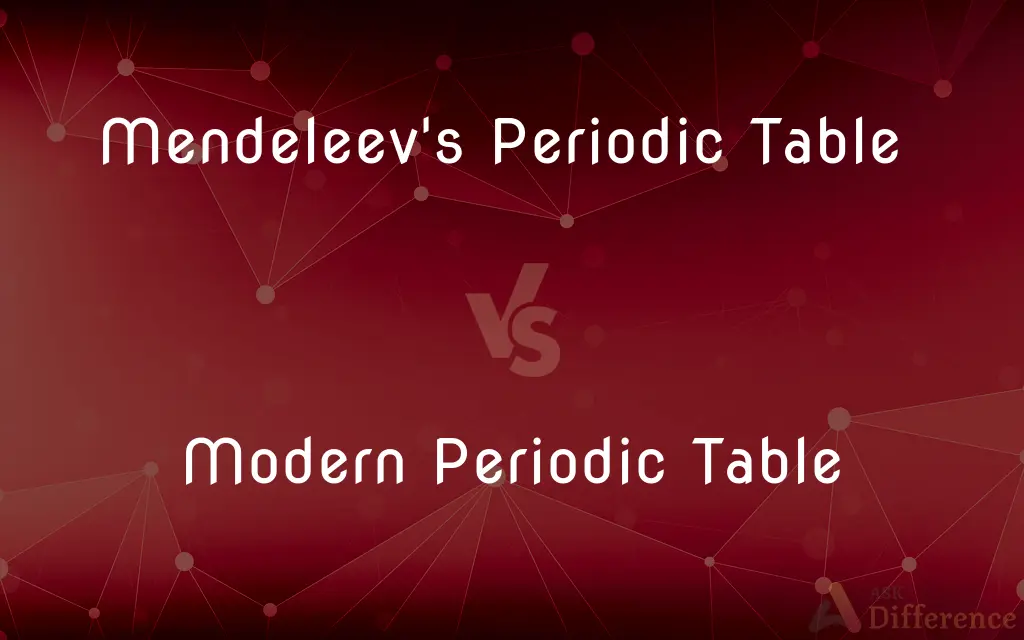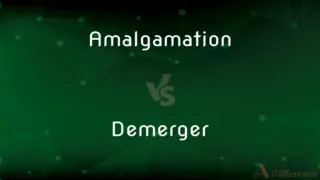Mendeleev's Periodic Table vs. Modern Periodic Table — What's the Difference?
Edited by Tayyaba Rehman — By Fiza Rafique — Published on December 14, 2023
Mendeleev's Periodic Table was an early arrangement of elements based on atomic masses, with gaps for undiscovered elements. The Modern Periodic Table is based on atomic number and is more extensive and precise.

Difference Between Mendeleev's Periodic Table and Modern Periodic Table
Table of Contents
ADVERTISEMENT
Key Differences
In the context of Mendeleev's Periodic Table, it was Dmitri Mendeleev, a Russian chemist, who formulated this arrangement in 1869. He categorized elements based on their atomic masses and left spaces for those yet to be discovered, predicting their properties. On the other hand, the Modern Periodic Table has evolved significantly since Mendeleev's time. It organizes elements based on atomic number, not atomic mass.
Mendeleev's Periodic Table was groundbreaking for its time. Mendeleev's genius lay not just in organizing known elements but in forecasting the existence of elements that hadn't been discovered. This visionary approach set the foundation for future developments. In contrast, the Modern Periodic Table benefits from over a century of advancements in atomic theory and quantum mechanics. This has led to a more systematic arrangement, classifying elements into groups and periods according to their atomic number.
One distinguishing feature of Mendeleev's Periodic Table was its flexibility. Mendeleev sometimes positioned elements out of order by atomic mass to fit them into groups with similar properties. This intuitive approach was largely accurate, but not always precise. The Modern Periodic Table, with its emphasis on atomic number, has a more consistent and precise ordering system.
Mendeleev's Periodic Table was not universally accepted during his lifetime. He faced criticism and skepticism, but his predictions about undiscovered elements eventually proved correct, solidifying his legacy. The Modern Periodic Table, building on Mendeleev's foundation, has been refined through collaborative international efforts and is accepted universally today.
Another significant difference lies in the sheer number of elements. Mendeleev's Periodic Table had gaps, anticipating future discoveries. The Modern Periodic Table has grown to include all known elements, with spaces for possible future elements at its end.
ADVERTISEMENT
Comparison Chart
Basis of Arrangement
Atomic Mass
Atomic Number
Predictions
Had gaps for undiscovered elements
Contains all known elements
Ordering
Sometimes out of order to fit properties
Consistent by atomic number
Acceptance
Faced initial skepticism
Universally accepted
Extensions
Limited to his time's knowledge
Updated with every new discovery
Compare with Definitions
Mendeleev's Periodic Table
The precursor to our modern understanding of elemental organization.
The Mendeleev's Periodic Table laid the groundwork for future chemical discoveries.
Modern Periodic Table
An arrangement of elements based on increasing atomic number.
The Modern Periodic Table is used universally in chemistry education and research.
Mendeleev's Periodic Table
A 19th-century table with gaps for then-undiscovered elements.
Using Mendeleev's Periodic Table, scientists predicted the properties of gallium.
Modern Periodic Table
A chart reflecting current knowledge from atomic theory and quantum mechanics.
The Modern Periodic Table provides insights into atomic structure and electron configurations.
Mendeleev's Periodic Table
Mendeleev's visionary method of grouping elements by similarities.
The Mendeleev's Periodic Table highlighted the periodic nature of elemental properties.
Modern Periodic Table
A systematic layout that groups elements into periods and groups.
Using the Modern Periodic Table, one can predict an element's reactivity.
Mendeleev's Periodic Table
An elemental arrangement that occasionally placed elements out of atomic mass order to fit chemical properties.
In Mendeleev's Periodic Table, tellurium and iodine were an anomaly.
Modern Periodic Table
The evolution and refinement of Mendeleev's foundational work.
The Modern Periodic Table has refined Mendeleev's initial vision with precise categorizations.
Mendeleev's Periodic Table
Mendeleev's initial chart that organized elements by atomic mass.
The Mendeleev's Periodic Table was a pioneering step in understanding elemental properties.
Modern Periodic Table
The up-to-date table representing all known elements.
New elements, when discovered, are added to the Modern Periodic Table.
Common Curiosities
Did Mendeleev's Periodic Table have any predictions for future elements?
Yes, Mendeleev's Periodic Table had gaps for undiscovered elements, predicting their properties.
How does the Modern Periodic Table organize elements?
The Modern Periodic Table organizes elements based on atomic number.
Does the Modern Periodic Table still grow?
Yes, as new elements are discovered, they are added to the Modern Periodic Table.
Why did Mendeleev sometimes order elements out of atomic mass sequence?
Mendeleev prioritized fitting elements into groups with similar properties over strict atomic mass order.
What was the basis for Mendeleev's Periodic Table?
Mendeleev's Periodic Table was based on atomic masses.
Are there any elements in the Modern Periodic Table that were not in Mendeleev's version?
Yes, the Modern Periodic Table includes many elements discovered after Mendeleev's time.
What was a unique feature of Mendeleev's Periodic Table in terms of elemental prediction?
Mendeleev's Periodic Table had spaces reserved for elements yet to be discovered, predicting their properties.
Was Mendeleev's Periodic Table immediately accepted in his time?
No, Mendeleev's Periodic Table faced skepticism initially but gained acceptance as his predictions proved correct.
Is the Modern Periodic Table universally accepted today?
Yes, the Modern Periodic Table is accepted and used universally in the scientific community.
How many elements did Mendeleev's Periodic Table initially have?
Mendeleev's Periodic Table initially featured 63 elements.
How are elements grouped in the Modern Periodic Table?
In the Modern Periodic Table, elements are grouped into periods (horizontal rows) and groups or families (vertical columns).
What is the most significant difference between Mendeleev's and the Modern Periodic Table?
The most significant difference is the basis of arrangement: atomic mass for Mendeleev's and atomic number for the Modern table.
Did Mendeleev's Periodic Table include all known elements of his time?
Mendeleev's Periodic Table included most elements known in his time, but he left gaps for undiscovered ones.
Share Your Discovery

Previous Comparison
Rubber Wood vs. Hardwood
Next Comparison
Amalgamation vs. DemergerAuthor Spotlight
Written by
Fiza RafiqueFiza Rafique is a skilled content writer at AskDifference.com, where she meticulously refines and enhances written pieces. Drawing from her vast editorial expertise, Fiza ensures clarity, accuracy, and precision in every article. Passionate about language, she continually seeks to elevate the quality of content for readers worldwide.
Edited by
Tayyaba RehmanTayyaba Rehman is a distinguished writer, currently serving as a primary contributor to askdifference.com. As a researcher in semantics and etymology, Tayyaba's passion for the complexity of languages and their distinctions has found a perfect home on the platform. Tayyaba delves into the intricacies of language, distinguishing between commonly confused words and phrases, thereby providing clarity for readers worldwide.











































